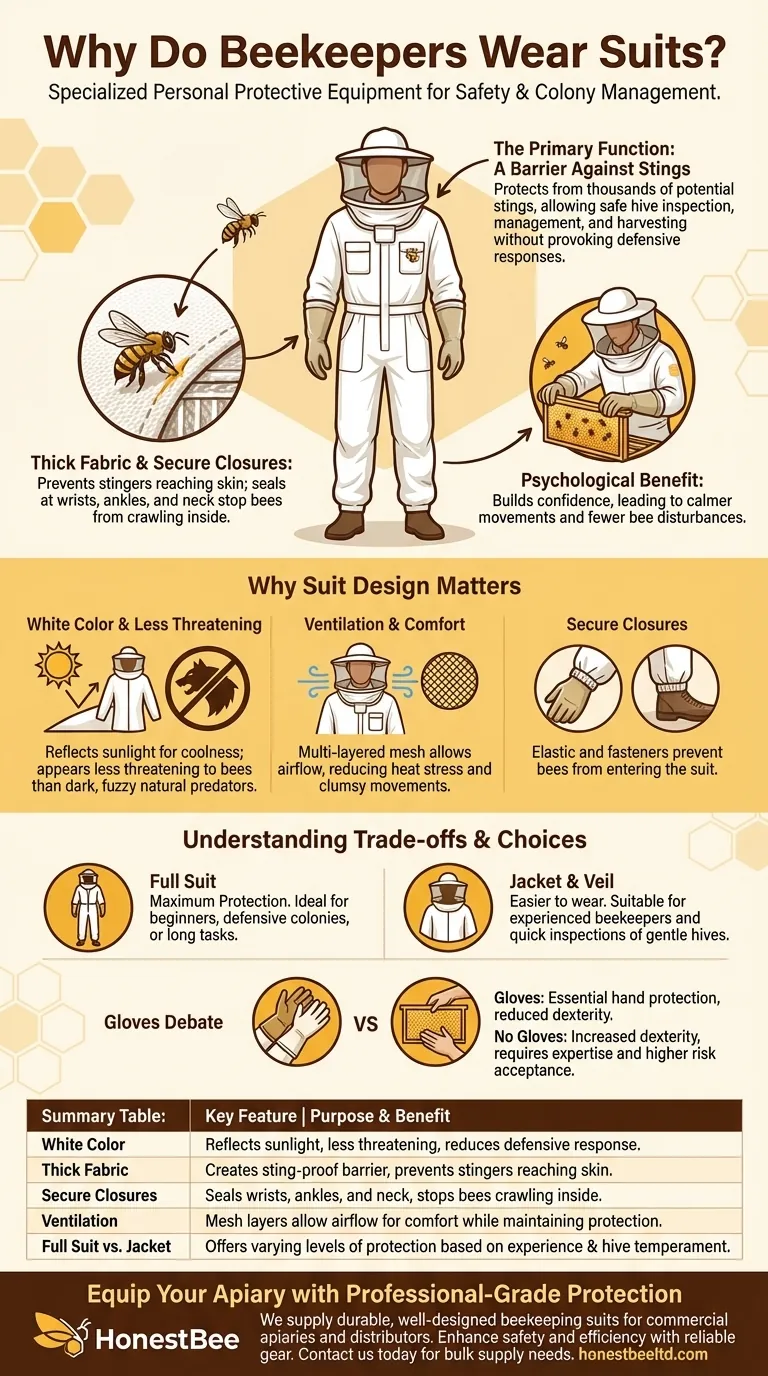At its core, a beekeeper's suit is a specialized form of personal protective equipment. Its primary and most critical function is to protect the wearer from bee stings. This barrier allows beekeepers to safely inspect hives, manage the colony, and harvest honey without provoking a defensive response or enduring painful injuries.
While the immediate goal is sting prevention, the specific design of a bee suit—from its color to its material—is a deliberate system engineered for both the beekeeper's safety and the bee colony's calmness.

The Primary Function: A Barrier Against Stings
A honeybee colony can contain tens of thousands of individual bees. When they perceive a threat to their hive, their collective defensive response can be overwhelming. The suit is the first and most important line of defense.
How a Suit Prevents Stings
The fabric of a bee suit is thick enough to prevent a bee's stinger from reaching the skin. The design also incorporates secure closures at the wrists, ankles, and neck to stop bees from crawling inside the clothing.
Protecting Clothing and Confidence
Beyond stings, suits are also practical for avoiding stains. Bees produce a sticky, resinous substance called propolis to seal cracks in the hive, and it can permanently stain regular clothing.
A suit also provides a significant psychological benefit, allowing a beekeeper to move calmly and deliberately, which in turn keeps the bees calmer.
Why Suit Design Matters
Modern bee suits are more than just simple coveralls. Every feature is intentional, designed to influence bee behavior and improve the beekeeper's working conditions.
The Significance of the Color White
Bee suits are almost universally white or a very light color for two key reasons. First, light colors reflect sunlight, helping to keep the beekeeper cooler during long hours in the sun.
Second, bees have evolved to recognize dark, fuzzy shapes as natural predators, like bears or skunks. A white suit is less threatening and is less likely to trigger an aggressive, defensive reaction from the colony.
The Role of Ventilation
Working in a full suit on a hot day can be strenuous. To combat this, many modern suits are ventilated, constructed with multiple layers of mesh that allow for airflow while still being sting-proof.
This improved comfort allows a beekeeper to remain focused and calm, reducing the risk of clumsy movements that could startle the bees.
Understanding the Trade-offs and Choices
Not all beekeepers wear a full suit for every task. The level of protection chosen often depends on the individual's experience and the specific hive's temperament.
Full Suit vs. Jacket and Veil
A full suit offers head-to-toe protection and is the standard for beginners or when working with a particularly defensive colony.
An experienced beekeeper performing a quick inspection on a known gentle hive might opt for a bee jacket and veil, which is easier to put on and offers protection for the upper body and head.
The Debate Over Gloves
Gloves provide essential protection for the hands, the area most likely to be stung. However, they reduce dexterity.
Some highly experienced beekeepers prefer to work without gloves to handle frames and equipment more delicately, though this requires a deep understanding of bee behavior and carries a higher risk.
Making the Right Choice for Your Goal
The decision on what protective gear to wear is a balance of safety, comfort, and the nature of the task at hand.
- If your primary focus is maximum safety as a new beekeeper: A full, ventilated white suit with gloves is the non-negotiable standard for building confidence and preventing injury.
- If your primary focus is a quick inspection of a known calm hive: An experienced beekeeper may find a jacket and veil combination to be sufficient protection.
- If your primary focus is working with a highly defensive colony: Full protection, including gloves and a sealed suit, is the only responsible choice.
Ultimately, wearing the proper protective gear empowers you to be a better, more confident steward of your bees.
Summary Table:
| Key Feature | Purpose & Benefit |
|---|---|
| White Color | Reflects sunlight, appears less threatening to bees, reduces defensive response. |
| Thick Fabric | Creates a sting-proof barrier to prevent bee stingers from reaching the skin. |
| Secure Closures | Seals wrists, ankles, and neck to stop bees from crawling inside the suit. |
| Ventilation | Mesh layers allow airflow for comfort while maintaining protection. |
| Full Suit vs. Jacket | Offers varying levels of protection based on experience and hive temperament. |
Equip your apiary with professional-grade protection from HONESTBEE. We supply durable, well-designed beekeeping suits and equipment tailored for commercial apiaries and distributors. Our wholesale-focused operations ensure you get reliable gear that enhances safety and efficiency for your beekeepers. Contact us today to discuss your bulk supply needs and keep your teams protected.
Visual Guide

Related Products
- Cotton Beekeeping Suit and Round Hat with Veil Bee Keeper Protective Gear
- 3 Layer Mesh Vented Sting Proof Beekeeping Suit with Hat and Veil
- Vented Beekeeping Jacket with Hood and Veil for Beekeepers
- Yellow Plastic Bucket Pail Perch for Beekeeping
- Heavy-Duty Stainless Steel Clip-On Frame Perch
People Also Ask
- What factors should be considered when choosing a beekeeping suit? Balance Safety, Comfort & Performance
- What is recommended for beginners in beekeeping regarding protective clothing? A Complete Safety Guide for New Beekeepers
- Why is a jacket with a hat veil recommended for beekeepers? Essential Protection for Your Face and Neck
- Why is white the predominant color in bee suit designs? | Key to Hive Calm & Beekeeper Safety
- How should a beekeeping suit be hung to maintain its shape? Protect Your Investment with Proper Storage



















